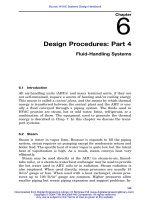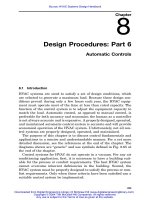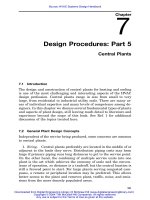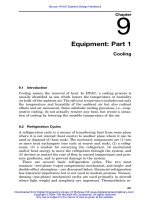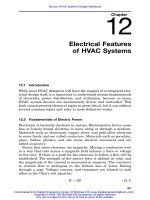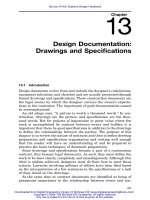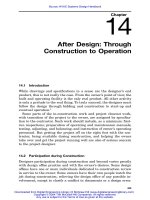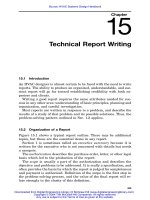HVAC Systems Design Handbook part 14
Bạn đang xem bản rút gọn của tài liệu. Xem và tải ngay bản đầy đủ của tài liệu tại đây (71.32 KB, 10 trang )
429
Chapter
14
After Design: Through
Construction to Operation
14.1 Introduction
While drawings and specifications in a sense are the designer’s end
product, this is not really the case. From the owner’s point of view, the
built and operating facility is the only real product. All other activity
is only a prelude to the real thing. To truly succeed, the designer must
follow the design through bidding and construction to start-up and
eventual operation.
1
Some parts of the in-construction work and project closeout work,
with transition of the project to the owner, are assigned by specifica-
tion to the contractor. Such work should include, as a minimum: first-
run inspections; preparation of operating and maintenance manuals;
testing, adjusting, and balancing; and instruction of owner’s operating
personnel. But getting the project off on the right foot with the con-
tractor, being available during construction, and helping the owner
take over and get the project running well are also of serious concern
to the project designer.
14.2 Participation during Construction
Designer participation during construction and beyond varies greatly
with design office practice and with the owner’s desires. Some design
offices have one or more individuals dedicated to construction review
in service to the owner. Some owners have their own people watch the
job during construction, relieving the design office of any possible in-
volvement, except to clarify a conflict in documents or a design error.
Source: HVAC Systems Design Handbook
Downloaded from Digital Engineering Library @ McGraw-Hill (www.digitalengineeringlibrary.com)
Copyright © 2004 The McGraw-Hill Companies. All rights reserved.
Any use is subject to the Terms of Use as given at the website.
430 Chapter Fourteen
14.2.1 Bidding period
When the project design is completed, drawings and specifications are
given to contractors with a request to prepare a proposal, to submit a
bid. During the bidding period, the bidders may identify missing in-
formation and discrepancies or errors in the documents. The owner
may identify additional services or installations which are wanted as
part of the contract. In each case, the designer will prepare clarifying
information which is added to the documentation by an addendum.
Addendum information should have the same character and quality
as the original documents.
When the contractors submit their bids, the bids may be opened
publicly and read aloud, as in the case of most government institu-
tions, or they may be opened privately, as is more common in industry
and private enterprise. Public bid openings are often quite exciting if
there are several bidders and if the bidding is quite close. Thousands,
sometimes millions, of dollars of work for a contractor may hang on
just a few dollars’ difference in the bid offering.
Bidding is the marketing effort for the typical contractor and is an
established mechanism for finding the right price for a scope of work.
Preparation of a bid for a project is typically time-consuming and may
involve considerable expense for a bidding contractor. Where several
contractors with many subcontractors are involved in a takeoff, yet
only one team can succeed, it is clear that all bidders should be treated
with respect for their effort.
14.2.2 Submittal (shop drawing) review
As a part of quality control for a project, the contractor is usually
required to show her or his intentions for materials, equipment, and
construction technique to the owner prior to ordering, delivery, and
installation. The owner’s representative, who may be the designer of
the work or an associate or another appointed agent, then reviews the
contractor’s submittals for conformance to the specifications. The con-
tractor is usually required to verify that he or she, too, has checked
the submittal for quality and conformance. Even though contractually
the submittal is checked only against the drawings and specifications,
there are the background questions such as the correct size, coordi-
nation between trades (adequate structure, adequate access, correct
electrical support). This joint review creates one more opportunity for
checking the design in the sense of ‘‘measure twice, cut once.’’
Submittal information is usually stamped with a note of acceptance
or rejection, with written clarification of observed deviations or
omissions. See Fig. 14.1.
After Design: Through Construction to Operation
Downloaded from Digital Engineering Library @ McGraw-Hill (www.digitalengineeringlibrary.com)
Copyright © 2004 The McGraw-Hill Companies. All rights reserved.
Any use is subject to the Terms of Use as given at the website.
After Design: Through Construction to Operation 431
NO EXCEPTIONS TAKEN AMEND-RESUBMIT
MAKE CORRECTIONS NOTED REJECTED-RESUBMIT
REVIEWED BY: DATE:
RECOMMENDED BY: DATE:
CORRECTIONS OR COMMENTS MADE ON CONTRACTOR’S SHOP
DRAWINGS DURING THIS REVIEW DO NOT RELIEVE THE CON-
TRACTOR FROM COMPLIANCE WITH CONTPACT DRAWINGS AND
SPECIFICATIONS. THIS SHOP DRAWING HAS BEEN REVIEWED FOR
CONFORMANCE WITH THE DESIGN CONCEPT AND GENERAL
COMPLIANCE WITH THE CONTRACT DOCUMENTS ONLY. CON-
TRACTOR IS RESPONSIBLE FOR: CONFIRMING AND CORRELAT-
ING ALL QUANTITIES AND DIMENSIONS; FABRICATION PRO-
CESSES AND TECHNIQUES; COORDINATING WORK WITH OTHER
TRADES; AND SATISFACTORY AND SAFE PERFORMANCE OF THE
WORK.
Figure 14.1
Typical shop drawing review stamp.
Because construction is based on a contract between the owner and
the contractor, the designer or submittal reviewer needs to be careful
not to assume contractor responsibility in her or his review. In these
days of increasing litigation, the language of review has evolved from
approved to no exceptions taken, or some similar noncommittal ex-
pression, meaning that the reviewer finds no apparent fault, but still
leaves the responsibility for conformance to the contractor. Such fancy
footwork notwithstanding, material will occasionally show up on the
job which is not really what was wanted or needed. Rejection at such
a late date is awkward and sometimes embarrassing, but it is better
handled sooner than later. The designer or reviewer needs to be ac-
quainted with the design intent in this phase of the work.
14.2.3 Work oversight and field review
The designer can only expect what the designer inspects!
Periodically during construction the project designer or an assigned
representative should visit the project to review the work accom-
plished and to answer questions that may arise. Sometimes a clari-
fying sketch or an explanation of design intent is all that is needed.
Sometimes the designer will want to check material and equipment
at the job site for conformance to documents and to submittal infor-
mation. This is done to confirm to the owner that the project is being
installed in a correct manner. Given the adversarial nature of fixed-
cost construction (the owner wants the maximum for his or her dollars,
After Design: Through Construction to Operation
Downloaded from Digital Engineering Library @ McGraw-Hill (www.digitalengineeringlibrary.com)
Copyright © 2004 The McGraw-Hill Companies. All rights reserved.
Any use is subject to the Terms of Use as given at the website.
432 Chapter Fourteen
the contractor wants to maximize the dollars left over), there is an
element of fairness and integrity required of the designer in evaluat-
ing adequate contractor response to the document or contract re-
quirements. Construction review is shaky ground for a neophyte. Ex-
perience at the hands of a good mentor is invaluable.
14.2.4 Change orders
In the process of construction, nearly always a condition will arise that
is inadequately or incorrectly defined by the contract documents. Of-
ten this will be the result of conflicts with other trades, due to lack of
coordination among designers. A classic case of this occurred when the
HVAC inspector caught a deep concrete beam, ready to pour, without
the slot required to allow a large duct to pass through. (Fortunately
the forms were adjusted to provide the slot.) Hopefully, the condition
will be encountered before the constraints are cast in concrete or fab-
ricated in steel. Upon identifying the problem, the construction
team—designers and constructors—will seek a solution. Often an ad-
justment can be made which incurs no additional cost to the contrac-
tor, and the work proceeds. Sometimes correction of the problem cre-
ates additional cost and effort for the contractor, who then seeks added
compensation. Such is granted by change order to the contract. A
change order involves a documented scope of work, a price, and a time,
and it becomes part of the contract when it has been agreed to by all
parties. The pricing mechanism is sometimes awkward since the ele-
ment of competitive bidding is gone. Even as some owners will try to
obtain more service than the documents truly define, some contractors
will seek compensation beyond the value or cost of the added work. In
a field review, the designer must work hard to see that equity is main-
tained. When a design error is involved, the contractor is not inter-
ested in covering the cost, and some owners become an immediate
designer’s adversary. Design fees are typically inadequate to provide
contingency funds, even for small items. Errors-and-omissions insur-
ance protects against major lawsuits, but there is a cost range where
designers must fend for themselves. Fortunate is the designer who
works with an owner who realizes that no set of construction docu-
ments is perfect, that 2 to 3 percent of basic cost for added clarification
is reasonable, and that openly working through problems is better
than trying to hide or barter them away. Construction budgets should
contain a percentage, typically 10 percent, to allow for changes.
14.2.5 First-run inspection
There is an assumption that the basic work of each trade is complete,
that power is available to run equipment, and that devices can be
After Design: Through Construction to Operation
Downloaded from Digital Engineering Library @ McGraw-Hill (www.digitalengineeringlibrary.com)
Copyright © 2004 The McGraw-Hill Companies. All rights reserved.
Any use is subject to the Terms of Use as given at the website.
After Design: Through Construction to Operation 433
placed in operation without fear of damage. All equipment is verified
as ready to run with shipping stops and protective wrap removed,
protective covers in place, surfaces cleaned of construction spatter, ro-
tating parts able to move freely, etc. Valves and dampers are placed
in a normal position; fluid-handling systems have been flushed clean
and pressure-tested. Insulation may or may not be finished, but work
is at least in progress. Control installations are complete and may
have a first-time setup.
With all components essentially there, the commissioning team goes
from one device to the next, verifying basic function. Motors are jogged
to verify rotation; fans and pumps are run for enough time to see that
things are all right, that power is available where needed, and that
automatic valves and dampers will stroke.
The first run does not require calibration or test of capacity or ad-
justment. It merely confirms that the systems are intact, ready for
tuneup and test by the specialist.
14.2.6 Testing, adjusting, and balancing (TAB)
With all systems in place and all devices capable of operation, the TAB
team takes over to prepare the work for final delivery to the owner.
This team is best managed by the general contractor, who has ultimate
responsibility for the quality of the project and who can assign the
work of all subcontracts. The work of the team then usually proceeds
under the direction of an individual, or firm, independent of but work-
ing with the mechanical, sheet-metal, control, and electrical contrac-
tors, who can operate and adjust the systems without vested interest
and with broader experience than any one of the specialized contrac-
tors might have. Such a team leader is often referred to as a TAB
contractor but the need is broader than just TAB. What is needed is
an operator who can place a system in operation and tune it up to
optimal operating condition.
The system designer can be a help as well as a referee in the TAB
work. The designer knows the intent of the design and the anticipated
interrelationship between components. Some humility is required,
however, for many designers have little actual operating experience
and may not know how to manipulate and operate systems as well as
do some of the old hands.
It is essential to have a member of the owner’s eventual operating
staff on hand for the start-up and TAB work. Early familiarity with
and knowledge of the system minimizes questions later on. Some con-
tractors, even designers, are reluctant to expose unfinished work to
the owner’s staff because the loose ends of a major work are sometimes
After Design: Through Construction to Operation
Downloaded from Digital Engineering Library @ McGraw-Hill (www.digitalengineeringlibrary.com)
Copyright © 2004 The McGraw-Hill Companies. All rights reserved.
Any use is subject to the Terms of Use as given at the website.
